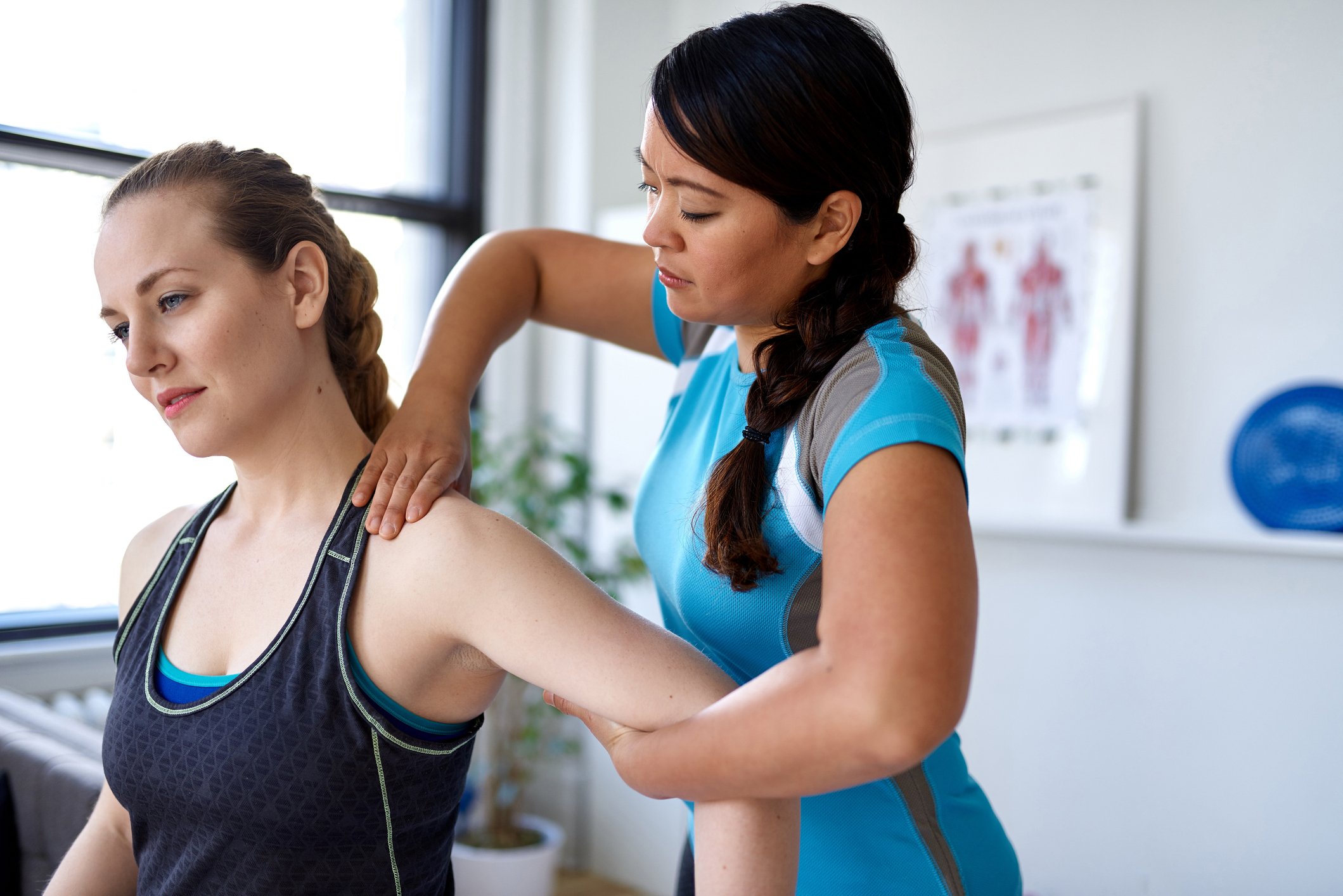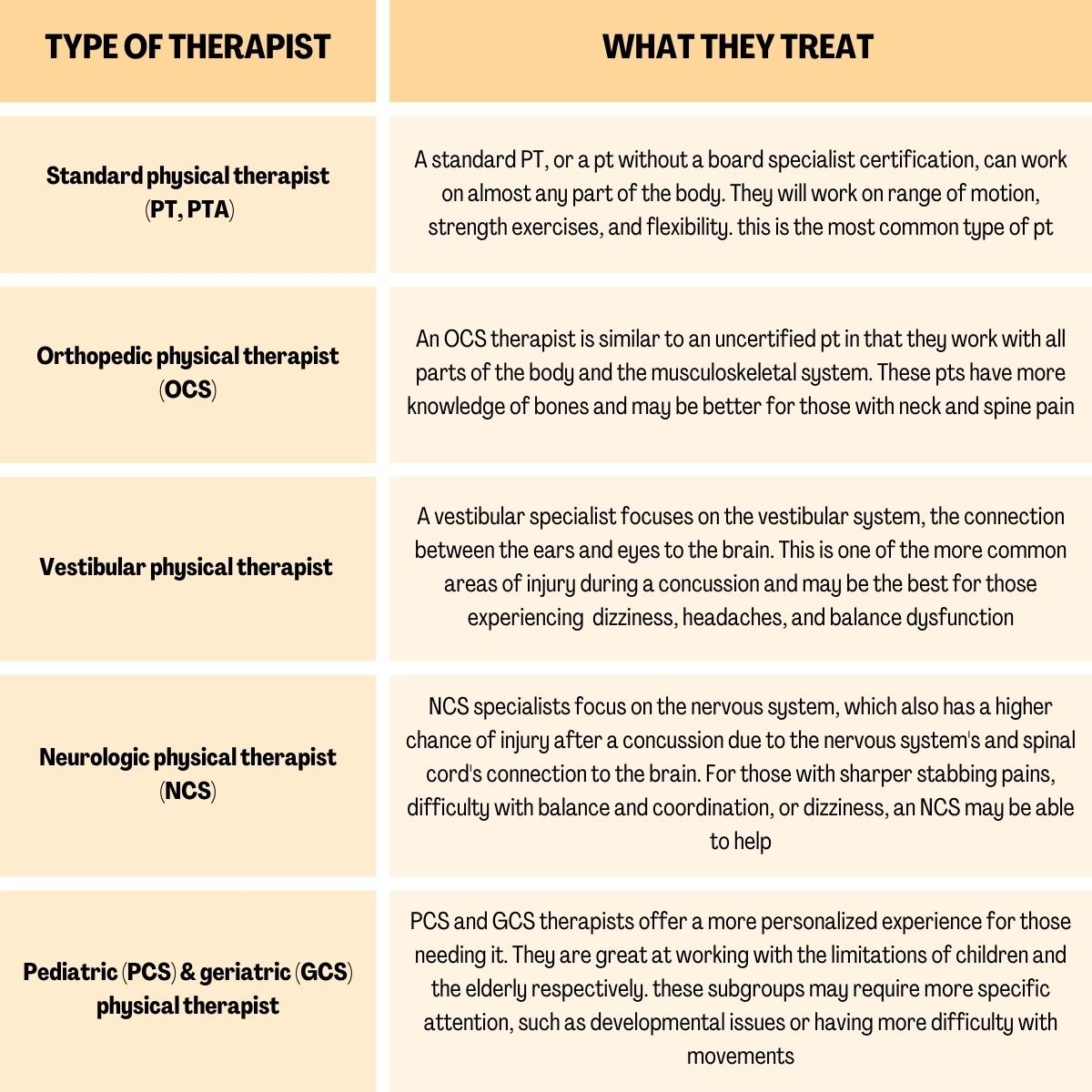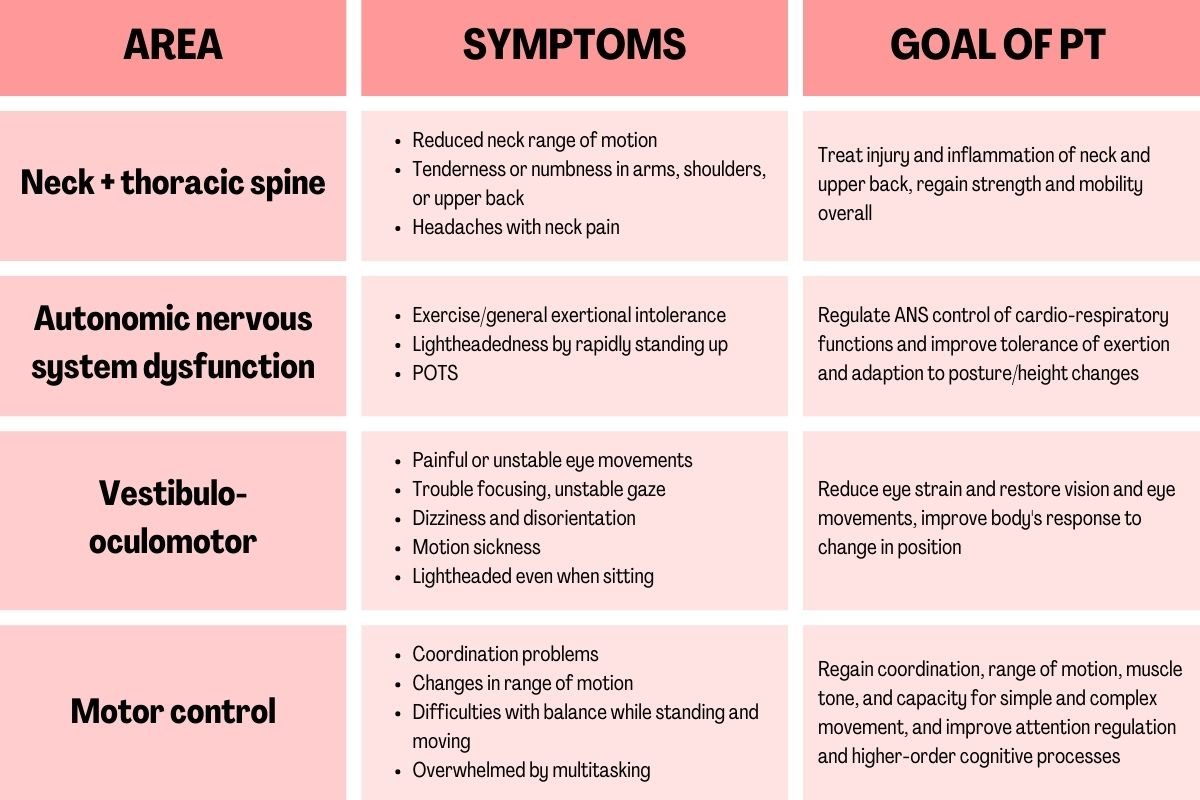Physical Therapy
Why You Should Consider Working with a Physical Therapist (PT)
A concussion is a “rehabilitative injury,” meaning physical therapists (PTs) can play a significant role in rehabilitation. Physical therapists are trained to treat concussion symptoms and subsequent dysfunctions in the visual or vestibular systems, the autonomic nervous system, motor (movement) function, and the cervical spine (neck) region. PTs can contribute to the recovery process, and participating in physical therapy can lead to healthier outcomes for concussion patients. However, not every PT is created equal, and depending on the problem, different therapists may be able to provide more assistance than others.
How a PT helps the concussion recovery process
Physical therapy applies a physical therapist’s knowledge of how the body operates as an integrated system. When there is a problem in the body, it is usually not as simple as just one dysfunction. Since the body is a complex system, it requires skill to correctly identify where the problems may have formed and what exercises will address those dysfunctions to return the body to its normal state. Physical therapists work with patients to help them achieve their unique goals.
There are many branches of physical therapy, each specializing in a different part of the body. Physical therapists will often target the neck, upper back, and skull in concussion patients; these are common symptom generators, especially for headaches and dizziness, and are often the leading cause of persisting symptoms after concussion. However, dizziness, headaches, or vertigo may also be driven by dysfunctions in the vestibular (balance) system and require the work of a PT specializing in vestibular therapy. Finding which therapist is right for you is important and can be the difference between faster recovery and persisting symptoms.
When you should see a physical therapist
One of the top ways a PT can be beneficial is in preventing or reducing the risk of persisting symptoms after concussion through early intervention.
Seeing a PT early, within the first 1-2 weeks, may reduce the chances of persisting symptoms. A type of physical therapy called cervicovestibular rehabilitation, should be started early if a concussion patient has headaches, neck pain, or dizziness persisting for more than 10 days. If you are experiencing persisting headaches, neck pain, or dizziness, it may make sense to request a referral to a PT with cervicovestibular experience as soon as possible or during your first doctor’s visit since referrals take time to process.
Most concussion symptoms typically resolve within 4 weeks, although some people will see symptoms that persist longer than this. Symptoms are considered to be “persisting” if they last more than 4 weeks, at which point a concussion patient should be seen by a clinician or, ideally a multidisciplinary team. Regardless of the setting, healthcare providers should conduct multiple types of assessments to help determine which systems of the body are being impacted by the concussion and which kinds of treatments the patient should be referred for. PT is a great way to resolve persisting symptoms that may be lingering for months or even years after the original injury.
The sooner you can see a therapist after a concussion, the easier it can be to treat the symptoms. However, that isn’t to say that those who have been dealing with persisting symptoms for longer–months or even years–can’t also benefit from physical therapy. In fact, it has been shown that PT at any point after a concussion, as long as you still have symptoms to be resolved, can aid in your recovery.
Red flag symptoms
If you experience any of the symptoms listed on our “red flag symptoms” page, please go to your nearest emergency department before seeing a PT. Other red flags indicating serious injury to the cervical spine (based on the Canadian C-Spine Rules) or spinal cord include complete loss of sensation/movement in the arms, loss of bowel control, inability to turn the head/neck 45 degrees, swelling and numbness/tingling in the lower limbs.
Choosing the right physical therapist for you
Choosing the right therapist can be challenging; a physical therapist isn’t a jack of all trades! Physical therapy has many specialties and subspecialties; finding the right therapist for your symptoms can be crucial.
The most common symptoms after a concussion are headaches, dizziness, and vertigo. These symptoms can be caused primarily by three different systems within the body: the musculoskeletal (neck and spine), the vestibular system, and the autonomic nervous system. There are PTs with certifications who specialize in these areas and PTs without certifications that may still be experienced. The two types of certifications are Orthopedic (OCS) and Neurologic (NCS). Orthopedic therapists specialize in the musculoskeletal system and are most similar to an uncertified PT. Neurologic PTs work on the nervous system and benefit those with vestibular or ANS dysfunctions. It is important to understand the order in which you should see them.
A concussion patient might best look for two types of PTs, neurologic and orthopedic. Since the neck and the vestibular system can generate headaches and dizziness after a concussion, it is recommended to see an orthopedic specialist first. Patients whose headaches and dizziness are caused by the neck may or may not also need to see a vestibular specialist, but those who require both specialists will need to get their neck treated first. Vestibular therapy often requires intense neck movements. A vestibular therapist is your closest match to a concussion specialist because concussion symptoms tend to come in clusters, and vestibular therapists address sensory integration.
Our search tool allows patients to look for PT specialists in their area. Despite this search tool enabling you to search by specialists, specialist certifications are not mandatory to be a licensed physical therapist. Some physical therapists decide not to pursue board certification yet have many years of experience in their specialty. Consider calling your local PT office to find out how much experience they have.
General physical therapists (PT, PTA)
A general PT, or a PT without a specialist certification, can help anywhere you are experiencing pain. Even without a specific certification, a PT may still be experienced with different areas of the body. A PT’s job is to help the body maintain flexibility and movement while rebuilding or maintaining muscle throughout the affected areas. By stretching and working parts of the body affected by concussion, PTs can release tension or reduce inflammation that may be causing pain or discomfort. A PT may work on the range of motion and endurance in muscles through strength training, stretching, manual therapy, and other non-manual tissue treatment modalities.
A certified physical therapist has a PT credential after their name. You may also be assisted by a PTA (physical therapist assistant).
Orthopedic physical therapists (OCS)
Physical therapists who are orthopedic specialists can help with orthopedic or musculoskeletal pain, such as concussion-related neck and jaw pain. Orthopedic physical therapists are similar to unspecialized PTs in that they work on the musculoskeletal system and will have the patients engage in activities for gaining strength, increasing range of motion, and general exercise. They are more trained in the skeletal system, however, and may be better for those experiencing pain in their neck and spine.
A board-certified orthopedic specialist has an OCS credential (orthopedic clinical specialist) after their name.
Vestibular physical therapists
Another type of therapy specialty is a vestibular therapist. A PT with this type of certification specializes in the vestibular system. If you are dealing with dizziness, headaches, or vertigo, common symptoms after a concussion, a vestibular therapist may be the right choice. Vestibular therapists can oftentimes be best positioned to treat concussion symptoms as they focus on the systems that can become disrupted and cause dizziness, headaches, and balance dysfunction. To learn more about vestibular rehabilitation, visit our Vestibular Therapy page.
While there is no separate board certification for vestibular therapy, Neurologic PTs (NCS - see below) are trained in vestibular rehabilitation and often serve as vestibular therapists. Alternatively, vestibular therapists will acquire specialty certification in vestibular therapy through private companies that provide accredited continuing education.
Note our “Find Providers” section has instructions on how to search for Vestibular PTs. These search tools from professional associations don’t always find a specific kind of therapist in your area, so the second thing to try is an online search for “vestibular physical therapist” near you.
Neurologic physical therapists (NCS)
Neurologic physical therapists are focused on the nervous and vestibular systems, which have a high chance of sustaining an injury after a concussion due to the spinal cord and nervous system’s connection to the brain. Patients who would benefit from this specialist are those experiencing trouble with balance and coordination, experiencing dizziness, or sharp stabbing pains (instead of a dull or aching pain common in muscle strains). Physical therapists who are neurologic specialists can help with concussion symptoms such as dizziness and balance problems and symptoms stemming from autonomic nervous system dysfunction/dysregulation.
A board-certified neurologic specialist has an NCS credential (neurologic clinical specialist) after their name.
Note, our “Find Providers” section has instructions on how to search for Neurologic PTs. These search tools from professional associations don’t always find a specific kind of therapist in your area, so the second thing to try is an online search for “neurologic physical therapist” or “NCS physical therapist” near you.
Pediatric (PCS) and geriatric (GCS) therapists
There are also PTs who work primarily with children (pediatric patients) and older adults (geriatric patients). These therapists specialize in working with the age-specific considerations of children and the elderly respectively. Both subpopulations tend to have longer recovery times and may be more susceptible to persistent symptoms. Pediatric and geriatric therapists will also better understand restrictions that may arise within the body, such as developmental issues in children or aging-related difficulty with certain movements in the elderly.
A board-certified pediatric specialist has a PCS credential (pediatric clinical specialist) after their name, and a board-certified geriatric specialist has a GCS credential (geriatric clinical specialist) after their name.
If you would like to know more about pediatric concussions consider checking out our page here.
Occupational therapists
While occupational therapy is a different healthcare field than physical therapy, occupational therapists (OTs) may be a useful addition to your rehabilitative team. If you think of a physical therapist as focused on reducing your pain, dizziness, or improving your balance, then you can imagine an occupational therapist as focusing on how to get you back to everyday life. An occupational therapist focuses on daily tasks of living or tasks that are part of your occupation, working with the patient to meet goals that may be challenging with their current set of limitations. For example, a challenge can be around making a meal (shopping for a meal or planning a recipe). An OT works with patients to plan adjustments for tasks that are challenging so as to make the tasks easier to complete. Those who have concussion symptoms may have difficulty with executive functions or multitasking. An OT works to help patients get back to perform these tasks at a comfortable level or find new ways to complete the tasks they cause less pain or discomfort.
A certified occupational physical therapist has an OT credential (occupational therapist) after their name.
For more information check out our Occupational Therapy page.
Speech-language pathologists
Speech-language pathologists work on similar cognitive issues and help patients develop strategies for their deficits. They assess cognitive issues and prescribe rehab exercises. They also help patients develop strategies to manage their daily life, such as using a memory book, while working on cognitive rehabilitation.
Check out our page on Cognitive Rehabilitation, our page on Cognitive Dysfunction, or our section on speech-language pathologists (SLP).
Areas where physcial therapy can improve concussion recovery
Physical therapists are trained to notice posture, alignment, and tension throughout the body. A physical therapist’s extensive knowledge of the body allows them to design treatment programs like scheduled exercise prescriptions, stretches, manual therapy, or even subtle things like posture correction. Managing symptoms and stress is key to promoting healing. The American Physical Therapist Association (APTA) developed a set of clinical practice guidelines for concussion in 2020 to create common ground for what PTs assess and treat in concussion. These guidelines published in the Journal of Orthopedic Sport and Physical Therapy state that physical therapists focus on these areas:
Neck and thoracic spine
Many neuromuscular, skeletal and proprioceptive (position-sensing) structures of the neck (cervical spine) and upper back (thoracic spine) work together to stabilize the head, and injury to these tissues (such as whiplash or nerve pinching) often accompanies a concussion. Research shows that 9-13% of all ages who were seen for a concussion in the emergency department or other tertiary care centers had some kind of neck injury. In the pediatric population, 32.5% had cervical spine dysfunction after sports-related head injury. Even if not enough to warrant a clinical diagnosis of neck injury/dysfunction, excessive force and movement of the head usually affects the neck.
Individuals can also experience concussion symptoms like headache, disorientation, visual strain, sleep disturbances, and changes in mood from neck injuries alone, so it can be hard to pinpoint whether symptoms are coming from the neck or concussion. This is why focusing on the neck is essential in decreasing inflammation and allowing the brain to recover. The role of neck injury in concussion symptoms is often overlooked. A PT’s expertise in the targeted musculoskeletal treatment of the neck and upper back is extremely helpful not only to reduce symptoms but to restore the strength, mobility, and health of those stabilizing tissues and structures. Since the neck also receives a lot of information about the body’s position in space, and because vestibulo-oculomotor exercises involve lots of neck movement, targeting the neck early on may improve the ability to perform these exercises.
Autonomic nervous system dysfunction
There is a growing focus on autonomic nervous system (ANS) dysfunction after concussion and how PT can be particularly valuable to help, especially because of its role in persisting symptoms after concussion. The autonomic nervous system regulates involuntary functions like heartbeat, breathing rate, and digestion that are not under conscious control. It also controls the “fight or flight” and “rest and digest” responses. Damage to the primary ANS control center in the brainstem during a concussion is thought to be the cause of ANS dysregulation. There are three common types of ANS dysfunction after concussion: exertional intolerance, orthostatic intolerance, and POTS (postural orthostatic tachycardia syndrome). Exercise & orthostatic intolerance typically appear when symptoms start, while POTS is more commonly a persistent manifestation.
Disrupting the ANS’s control of the cardiovascular and respiratory systems causes an abnormal brain blood flow response, making low intensities of exercise feel more challenging than they are and triggering headache and dizziness early on. With orthostatic intolerance, abnormal brain blood flow is caused by upright positions rather than exercise, involving a drop in blood pressure that makes you feel faint when standing up. In POTS, the abnormal blood flow with upright positions is accompanied by a rapid increase in heart rate rather than a drop in blood pressure.
Refer to our page on Autonomic Nervous System Dysfunction after a concussion to learn more about symptoms and specialized treatment for this category.
Vestibulo-oculomotor
The visual (sight and eye movement) and vestibular (balance) systems communicate with each other to help your body understand its position in space. The APTA recognizes these systems as the combined “vestibulo-oculomotor” category of symptoms. Whenever there is disagreement in the information exchange between visual and vestibular input, symptoms like dizziness, motion sickness, disorientation, and depth perception problems occur. This can make it challenging to function and keep your balance in busy, visually stimulating environments like supermarkets, malls, classrooms, or even crossing the street and watching traffic lights change. Difficulties in sight and eye movement from a concussion can also exacerbate other aspects of the injury, like post-traumatic headaches.
Refer to our Vision Therapy and Vestibular Therapy pages to learn more about symptoms and treatment from PTs and other specialists for these categories.
Motor function impairments
Impairment in sensory information processing comes with impairment in motor control and movement. Both simple and complex movements can become impaired. Some common motor control symptoms include abnormal movements, inability to engage muscles, muscle rigidity or weakness, longer reaction time, changes in walking patterns (locomotion) and range of motion, and difficulty with coordination. Motor control problems slow the body’s defensive reactions (like pulling your finger away from a hot stove or braking early enough while driving) and increase the risk of falls and other injuries, including lower limb injury or another concussion.
“Dual-task” difficulty / cognitive control of movement
One particular common challenge for those with persistent symptoms is dual-task impairment. A “dual-task” is precisely what it sounds like - the execution of two tasks simultaneously, like walking and talking. In clinical settings, a dual task usually consists of a motor task and a cognitive task since motor control and movement planning involve higher-order cognitive processes, all of which are located in the same area of the brain (the frontal lobe).'
Whether motor, sensory, or cognitive, dual tasks require the ability to divide attention, which is very commonly affected by concussions. Sometimes persistent motor control deficits are not discernible in neurological motor exams, but a PT’s assessment of dual-task difficulty is a highly sensitive way to identify lingering motor control impairment. Dual tasks can also be an excellent rehabilitation tool; dual-task exercises can be designed to suit a patient’s individual recovery goals. Dual-task impairments can often persist after other symptoms have resolved, so it is especially important for athletes to have this assessed before returning to play.
Incorportating physical therapy into your rehabilitation
It is important to talk to your primary care physician and to be honest about your symptoms. Typically you need a referral to a physical therapist, and a primary care physician can provide that. However, it is important to remember that many of these providers are trained to deal with a broad scope of problems and that their specific knowledge of concussions may not be the most reliable or up-to-date; new research is always emerging in the field. If you feel your doctor is not doing enough to help you, you can take steps to help yourself. You can ask for a referral to PT or try showing your doctor this resource page. In some states, there are direct access laws to PT, and you do not need a referral from a doctor. Talking to a physical therapy clinic directly to ask what types of referrals are required for their service might prove more successful for some.
One of the best things you can do to improve concussion recovery on your own is to stay active. It was previously thought that many days of rest in a dark room were required to let the brain heal, but this is untrue and may actually slow recovery speed. Learn more about what is recommended for recovery on our Guidelines to Recovery page. Graduated exercise is the current best solution available. It is important to note that your body is still recovering and is in a more delicate state. Light-intensity and thoughtful exercise are crucial, but it is just as important not to push yourself too hard and to listen to your body when it says it is time to stop.
Graduated Aerobic Exercise
Light aerobic exercise is one of the most effective tools available right now for concussion recovery, making sure to avoid the risk of contact, collision, or fall. Returning to physical activity within 24-48 hours after sustaining a concussion is recommended. Be sure to start light and use caution if you have symptoms like dizziness or light-headedness, which may increase your risk of falling – but gradually increase intensity as you start to feel better. Taking 15-30 minute walks, or using an upright or recumbent stationary bicycle, can reduce symptoms and shorten recovery time. If you start seeing a significant rise in your symptoms, lasting over an hour after you stop exercising, you are pushing your body too hard. Symptoms provoked by exercise should be mild (not more than 1-2 points on a 10-point scale) and brief (lasting under 1 hour after stopping exercise).
Refer to our Graduated Exercise Therapy page for more information.
Understanding Your Body
The body is a complex system, and pain in one area of the body could be connected to a problem in a completely different place. Sometimes the body can enter a stiff and rigid state where it limits movements as a way to protect itself. Consistent exercise and movement lets your mind know that you are working toward repair, and these uncomfortable spots will get better over time as the body works to heal itself.
What to be wary of
There may be complications to be aware of when seeing a physical therapist. These may include pre-existing conditions, such as hypermobility. Those with hypermobility have been observed to occasionally have more severe concussion symptoms and a higher risk of other musculoskeletal injuries while concussed. This is for many reasons, such as the neck being unable to support itself as well in those with hypermobility, leading to worse whiplash and concussion outcome.
Another possible problem is POTS, or Postural Orthostatic Tachycardia Syndrome. This complication can arise after a concussion and manifest as rapid heartbeat and lightheadedness, fainting from long-standing or when moving quickly from sitting to standing. Informing your PT of this problem is very important so they do not push your body too much, and patients need care that considers this condition.
It is common to feel depressed or anxious after a concussion and want the quickest recovery possible, but pushing your body has the potential to do more harm than good. To learn more about concussion-related mental health, check out our Mental Health page and Cognitive Behavioral Therapy page.





















A study found that post-concussion neck symptoms were prevalent in patients experiencing acute and chronic symptoms following a concussion. Graded cervical manual therapy was found to “reduce time to symptom resolution and medical clearance.”